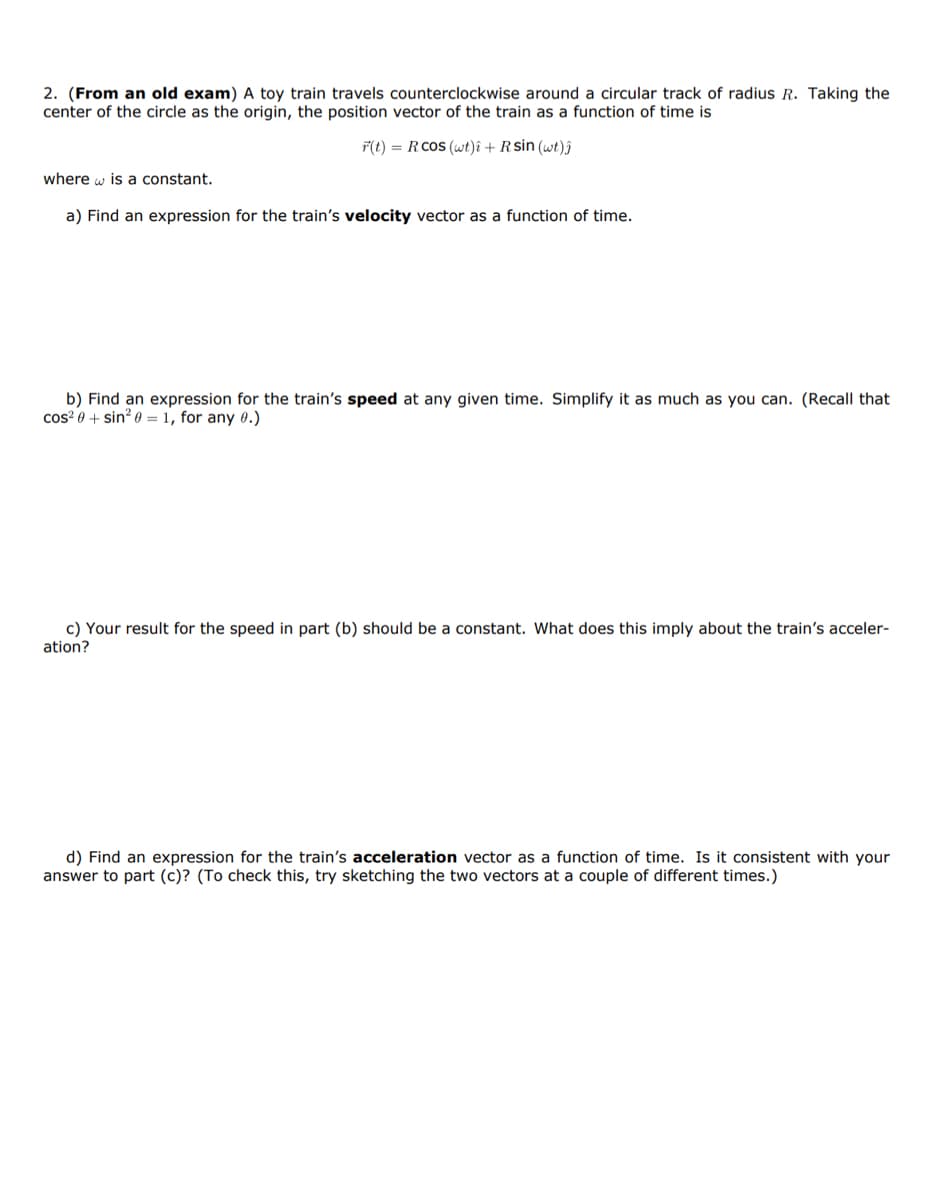2. (From an old exam) A toy train travels counterclockwise around a circular track of radius R. Taking the center of the circle as the origin, the position vector of the train as a function of time is F(t) = R Cos (wt)i + Rsin (wt)ĵ where is a constant. a) Find an expression for the train's velocity vector as a function of time. b) Find an expression for the train's speed at any given time. Simplify it as much as you can. (Recall that cos² 0 + sin² 0 = 1, for any 8.)
2. (From an old exam) A toy train travels counterclockwise around a circular track of radius R. Taking the center of the circle as the origin, the position vector of the train as a function of time is F(t) = R Cos (wt)i + Rsin (wt)ĵ where is a constant. a) Find an expression for the train's velocity vector as a function of time. b) Find an expression for the train's speed at any given time. Simplify it as much as you can. (Recall that cos² 0 + sin² 0 = 1, for any 8.)
An Introduction to Physical Science
14th Edition
ISBN:9781305079137
Author:James Shipman, Jerry D. Wilson, Charles A. Higgins, Omar Torres
Publisher:James Shipman, Jerry D. Wilson, Charles A. Higgins, Omar Torres
Chapter2: Motion
Section: Chapter Questions
Problem IM
Related questions
Question
2 B only please, show work

Transcribed Image Text:2. (From an old exam) A toy train travels counterclockwise around a circular track of radius R. Taking the
center of the circle as the origin, the position vector of the train as a function of time is
F(t) = RCOS (wt)i + R sin (wt)ĵ
where is a constant.
a) Find an expression for the train's velocity vector as a function of time.
b) Find an expression for the train's speed at any given time. Simplify it as much as you can. (Recall that
cos² 0+ sin² 0 = 1, for any 0.)
c) Your result for the speed in part (b) should be a constant. What does this imply about the train's acceler-
ation?
d) Find an expression for the train's acceleration vector as a function of time. Is it consistent with your
answer to part (c)? (To check this, try sketching the two vectors at a couple of different times.)
Expert Solution
This question has been solved!
Explore an expertly crafted, step-by-step solution for a thorough understanding of key concepts.
Step by step
Solved in 3 steps with 2 images

Knowledge Booster
Learn more about
Need a deep-dive on the concept behind this application? Look no further. Learn more about this topic, physics and related others by exploring similar questions and additional content below.Recommended textbooks for you

An Introduction to Physical Science
Physics
ISBN:
9781305079137
Author:
James Shipman, Jerry D. Wilson, Charles A. Higgins, Omar Torres
Publisher:
Cengage Learning

College Physics
Physics
ISBN:
9781285737027
Author:
Raymond A. Serway, Chris Vuille
Publisher:
Cengage Learning

Physics for Scientists and Engineers with Modern …
Physics
ISBN:
9781337553292
Author:
Raymond A. Serway, John W. Jewett
Publisher:
Cengage Learning

An Introduction to Physical Science
Physics
ISBN:
9781305079137
Author:
James Shipman, Jerry D. Wilson, Charles A. Higgins, Omar Torres
Publisher:
Cengage Learning

College Physics
Physics
ISBN:
9781285737027
Author:
Raymond A. Serway, Chris Vuille
Publisher:
Cengage Learning

Physics for Scientists and Engineers with Modern …
Physics
ISBN:
9781337553292
Author:
Raymond A. Serway, John W. Jewett
Publisher:
Cengage Learning

Physics for Scientists and Engineers
Physics
ISBN:
9781337553278
Author:
Raymond A. Serway, John W. Jewett
Publisher:
Cengage Learning

College Physics
Physics
ISBN:
9781938168000
Author:
Paul Peter Urone, Roger Hinrichs
Publisher:
OpenStax College

University Physics Volume 1
Physics
ISBN:
9781938168277
Author:
William Moebs, Samuel J. Ling, Jeff Sanny
Publisher:
OpenStax - Rice University